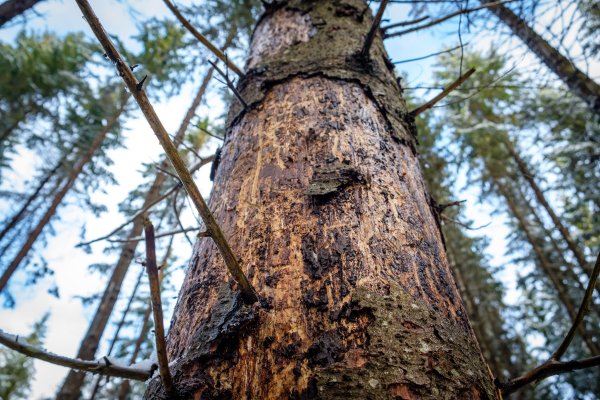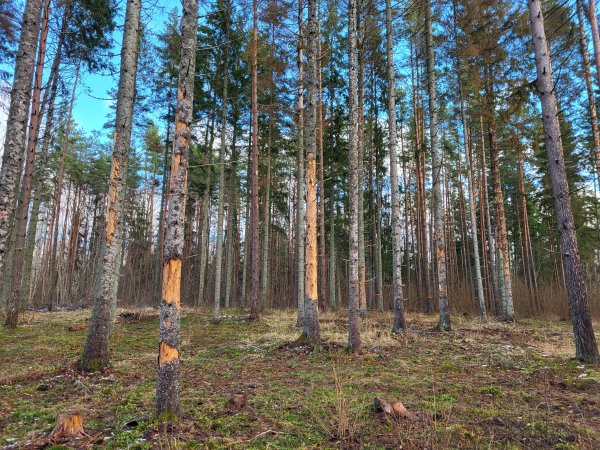Forestry Measures to be Taken to Limit the Spread of the European Spruce Bark Beetle in the Pokaiņi Forest
The climatic conditions of the last years have created favourable conditions for the risk of proliferation of the European spruce bark beetle. In the Pokaiņi Forest managed by JSC “Latvia's State Forests” (LVM), which is popular with holidaymakers for walks, the number of trees damaged by the European spruce bark beetle increases every year, and it threatens the safety of holidaymakers and can damage whole forest stands in a short time. To limit the spread of the pest and preserve the still intact and healthy trees in the forest stand, it is necessary to carry out forest management measures – logging – in the Pokaiņi Forest area.
The damage caused by the European spruce bark beetle can be found in the entire territory of the Pokaiņi Forest – both on the sides of roads and paths, and deeper in the forest stands. Therefore, within the framework of forest management works, already this winter logging works are planned in the Pokaiņi Forest and the adjacent territories. To give an update about the planned activities, employees of LVM Zemgale region met with the representatives of the Dobele region municipality in the Pokaiņi Forest on 31 January. During the meeting, the largest forest stands damaged by pests in the Pokaiņi Forest were visited and questions about the necessity and specifics of territory management were discussed.
“As part of forest management, logging works will be carried out both randomly, cutting down individual trees, as well as in continuous areas, creating clearings, depending on the situation in nature. Thus, we will reduce the risk of danger to forest visitors and improve the health of forest stands,” says Jānis Zitāns, Head of Forest Management Planning of LVM Zemgale region.
Although tree damage can be found throughout the entire the Pokaiņi Forest area, the work will first be carried out outside the places of concentration of stone piles, considering that they are covered with snow and are not visually noticeable.
Logging works were planned to start already in winter, when the number of tourists is smaller, so that the operation of forest machinery does not interfere with recreation in nature; however, considering the specifics of the territory, it will not be possible to clean up all the areas damaged by the dangerous pest during the winter period.
“In the places of concentration of stone piles, there is a distinctly variable terrain, which is crossed by a network of well-maintained paths, so logging at the moment, even with the gentlest technique available, would create significant risks of damage to the ground cover. To reduce the risks of damage to stone piles and the formation of ridges, we plan to carry out logging in these places during the snow-free period, in dry weather in the second half of summer, using small and precise equipment,” Jānis Zitāns, Head of Forest Management Planning, speaks about the progress of the work.
Once the spruces damaged by the pest are cut down and removed from the area, after evaluating the suitability of the soil, the largest clearings will be reforested with pine seedlings in order to create a larger proportion of pine forests in this area in the future.
According to Edijs Leišavnieks, Head of Forest Protection and Fire Fighting at LVM: “It is best to deal with the bark beetle, which is physically located in the trunks of trees, by carrying out sanitary clear felling or felling according to the sanitary opinion of the State Forest Service, and in the summer months to place pheromone traps in the clearing. This way, the beetles flying nearby are also caught, thus reducing the number of flying beetle populations that may threaten the adjacent spruce forests.”
LVM encourages visitors to the Pokaiņi Forest to be understanding and cautious, not to approach forest equipment during work.
What is the European spruce bark beetle?
The European spruce bark beetle (Ips typographus) is the most destructive pest of Norway spruce throughout its natural range in Europe and northern Asia. Hot, dry summers, as well as storms create favourable conditions for the spread of this pest when the bark beetle multiplies in wind-blown and broken fir trees. Often the damage caused by this pest far exceeds that caused by a storm.
The first flights of spruce bark beetles can start as early as the end of April, but their mass flight usually occurs around the first decade of May or in mid-May.
If the weather is dry, warm, and windless during this period, then these are clearly favourable conditions for the flying of the bark beetle, which occurs almost without interruption until September.




